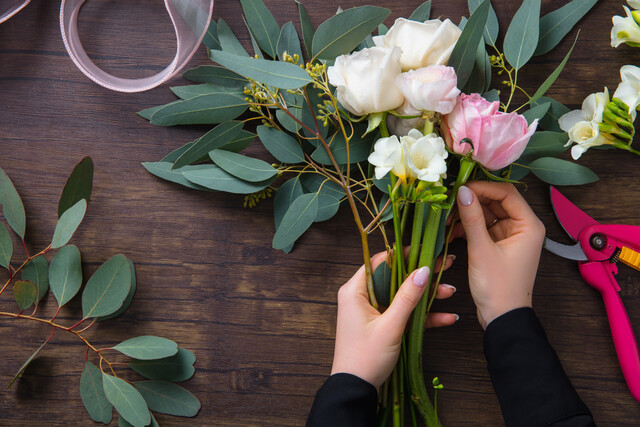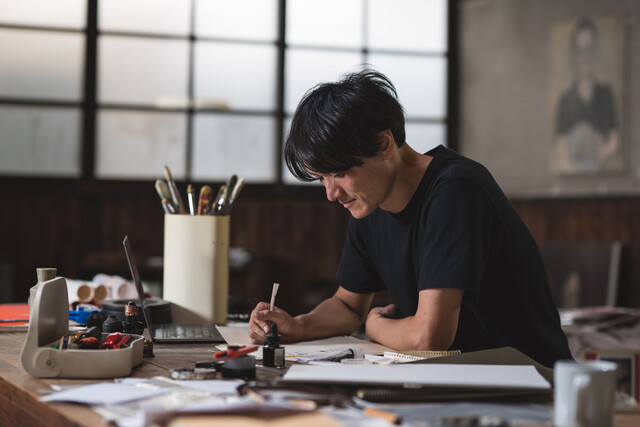Artificial Nails
If you have trouble growing out your nails, artificial nails are an option. Women who bite their nails have artificial nails applied to help kick their biting habit. Others are more concerned with vanity and want to have strong, beautiful nails to compliment their overall look. Artificial nails will not improve unhealthy nails. They may look beautiful, but can damage your nails permanently. Although claims are made, there is not one artificial nail that is better than another. A good manicurist skilled in applying artificial nails can make any artificial nail look good. You still must make time to go back to the manicurist for fills. If you don't do the maintenance, the nails could lift and a fungus can grow between your nail bed and the artificial nail. Before you decide on the type of artificial nails you want, talk to a manicurist and ask if she is skilled in the application of artificial nails, and how long she has been a manicurist. You want an expert.
Drugstores and beauty supply shops can supply whatever you need to apply your own artificial nails, but it's not easy to do and you may be unhappy with the results. Ask your friends who are wearing artificial nails if they are satisfied with them, with their manicurist and which of the following types of nails they are wearing:
Sculptured Nails
In this method, acrylic or gel is applied to your nails by using metal or foil to lengthen and sculpt the overlay. In some cases a plastic nail tip is applied with glue, then gel, silk or acrylic is laid over the entire nail. As the nail grows out, the manicurist fills in the growth area closest to the cuticle and files down the artificial tip (this is referred to as a fill) until, after several fills, you wind up with just the overlay on your natural nail.
Acrylic Nails
Acrylics last the longest and are the strongest of all the artificial nail overlays. If they are not well done, they can look thick and unprofessional. You need an expert manicurist to give your nails a thin, natural look. They should be filled every two or three weeks to prevent lifting. Acrylics are the most popular. Women who travel like them because it's easier to find a skilled manicurist in a different city to fill their nails.
Gel Nails
Silk, Fiberglass and Linen Wraps
Wraps are pieces of silk, fiber or linen cut to the shape of the nail and glued to the nail bed. This is always performed on natural nails and gives strength to allow the nail to grow in length. Silk is the most popular material used because it provides flexibility. If you do your own housework, have an active lifestyle or spend a lot of time baking and pickling in the kitchen, wraps may be too flimsy for you. Linen is a stronger material, but gives a thicker, less natural look. Fiberglass is really the best of both worlds since it provides the semblance of silk and the durability of linen.
Women who opt for fake nails could get more than they bargained for. Methyl methacrylate (MMA) is a contaminant removed from the beauty industry 25 years ago. This dangerous toxin has made a sneaky comeback in nail salons nationwide.
Why is this dangerous to health? Because it bonds so strongly to the natural nail, MMA can actually rip the nail from fingers if it is accidentally bumped. It may cause severe rashes and, over time, can harm the liver, kidneys and fetuses. MMA is being sold right under the FDA's noses. This harmful chemical is found mostly at discount salons because compared to $200 for safer and accepted products, it costs anywhere from $20 to $60 per gallon.
Liquid MMA is used by manicurists to build the sculptured or acrylic nails and it can be used in conjunction with solid materials to wrap the nail. Competition is very tough in nail salons and the cut-rate salons make it even tougher. Salon owners and manicurists often purchase the cheapest product they can find. Beauty supply shops are selling it with the attitude "if someone official tells us not to sell it, we'll stop."
The manicurists themselves who breathe MMA over time may suffer kidney and liver lesions, reproductive problems and possibly lung and cardiovascular damage. Not only are these manicurists cutting corners at their own physical expense, they are putting their clients in jeopardy.
Although artificial nails tend to look and wear better than natural nails, they do require time and maintenance. If you are considering artificial nails of any type, ask the manicurist if she uses MMA. If she doesn't know, find another trained and licensed professional.
Exercise � The next time your friend with artificial nails goes to her salon for a fill, ask her if you can observe the manicurist as she/he works. If this is so, tell the professional you are considering a full set of acrylic nails and you want to observe what is involved. Time your questions wisely. And wouldn't it be great if you could home manicure each other's artificial nails?
Applying an Acrylic Overlay
. You may have "my personal time" by having a pro do your acrylics, but you can save a bundle by learning to do your own acrylics. It's not easy, but many have mastered the process.
- Preparation - Remove any old polish on the surface of your nail with non-acetone polish. If you are working on natural nails, roughen them up a bit with a fine emery board or filing block. Trim the nails just to the skin at the tip. You can injure your natural nail if it snaps off because you didn't do the trimming step correctly. You do not want a lot of natural nail length. If you have fine dust around the cuticles, just brush it off with a dry brush. If you are doing an overlay without tips directly onto the natural nail, in this case, fiberglass works better than acrylic. If you are applying onto old acrylic, carefully remove the acrylic near the cuticle. Wear safety glasses for this because the acrylic can pop off and hit you in the eye. File the sharp acrylic edges lightly, take down the length if you want your nails shorter and remove any nail tip that needs to be replaced.
- Artificial Tips � Tips come in twenty sizes. Chose a good quality opaque brand. Find a size that fits your nail bed. You need a tip that is going to sit flush against your nail bed. If you can't find one to match your nail bed, file a comparable tip down a little on the sides. Line them all up like ducks in a row next to your nail glue, ready to apply.
- Nail Glue � Use just a drop to the artificial tip and place it over the white tip of your natural nail. If you see it's crooked, quickly remove it and start over again. If it has adhered to your natural nail, and you can't remove it, soak it off in non-acetate remover. Major nuisance. When you are finished applying the tips to one hand, because of their length, it may be difficult to complete the other hand. Trim them down with an artificial nail tip cutter before you move on.
- Determine Your Length � If this is your first time doing your own nails, use a nail tip cutter, cut them shorter and work up to the length you want. Don't cut them too short ? you can always file down the length. Compare each nail for uniformity. If this is your first time doing acrylic nails, don't expect them to look like a professional did them. It takes a while ? but think of all the money you'll save. File them roughly to your desired shape and length. Pointy nails are out, squared or oval shapes are in. You will be filing them again after the acrylic has dried.
- Liquid Acrylic and Acrylic Powder � Place a dampen dish (beauty supply store) on top of paper towel. Pour the liquid acrylic into the dish. It gives off a strong smell, and it helps to have good ventilation. Open your container of powder; you can dip right into the container if you don't over saturate your brush. Otherwise, place a small amount of powder into another dampen dish. The powder container can look pretty nasty over time.
- Laying Product � Here we go! Dip your brush into the liquid acrylic and dab both sides on the paper towel. Dip about � of your brush into the liquid again and sweep the bristles on the inner lip of the dampen dish once or twice. You don't want any excess liquid dripping into the powder. Dip the tip of the brush into your powder forming a moist ball of product at the tip. Practice will make perfect. Apply the ball of product to the seam of the tip and natural nail. Work quickly, smooth it in but don't flatten it. Wipe your brush on the paper towel to remove the excess product and dip your brush tip back into the liquid, wiping on the paper towel, if needed, or just remove the excess on the dish lip. Pay attention to how much your brush is picking up and how saturated it is. Repeat the steps over and over until the entire nail is covered with product. Be careful not to get the acrylic on the cuticle area. This can cause lifting, a sensitivity allergy, or worse, fungus. You never want to lay acrylic over a fungus until it has been treated and cleaned away.
- Build Up � As you work the product onto the nail you must do a build up. Make a small mound of product to mimic the natural curve of your natural nail. Apply a coat of product to the tip as well as the free edge.If you are right handed, the product on the right hand may not look as well as the product on your left hand. As you become more skilled at manicuring your acrylics, this tends to be less of a problem.
- File � After your acrylic is completely dry, (should take no more than ten minutes after product is laid onto the nail) file the sides closer to the cuticle with the medium grit file, shaping the built up area to look rounded and more natural. Continue filing the free edge until you have the desired length and shape. Place hands side by side to confirm the shape and length are the same.
- Smooth � Use a white filing block to smooth any bumps from the nail. This also helps smooth out beginner's irregularities.
- Scrub � Scrub your nails with warm, soapy water and always use a nail brush. This removes acrylic dust, excess chemicals or oil and prepares the nails for polish. Don't forget to scrub under your new acrylics.
- Polish � There is no need to apply base coat to the acrylics. Polish adheres well to acrylic. After two coats of polish, apply a fast drying topcoat to enhance shine and protect your polish. Last, apply nail oil to the cuticles to condition and moisturize. Congratulations! You have just completed your first acrylic nail application.
Useful Tips for Artificial Nails
-
- When an artificial nail cracks or splits, your best solution is mending tape and nail glue until you can visit your manicurist. If you don't have mending tape, cut a piece of teabag or coffee filter, dot with nail glue and cover the nail where damaged. File the nail smooth and cover with polish if desired.
- If a nail tip falls off, glue it back on with nail glue. Get to the salon as soon as possible so the nail can be filled at the patch to avoid fungus from forming beneath the nail.
- Pink and white acrylics only look their best when kept looking fresh and clean. Here is a simple and inexpensive technique to do just that:
w Dissolve one denture cleaning tablet in a bowl of warm water (follow directions on the package).
w Remove any polish with non-acetone remover.
w Soak your nails in the solution for five to ten minutes.
w Rinse well and dry.
w Repeat each week or whenever your acrylics look dingy.
- Keep your cuticles moisturized to avoid infection.
- Wear plastic or rubber gloves when coming in contact with harsh chemicals.
- Never use household glue to repair nails.
- Chose a reputable (beware of discount salons) salon and don't be afraid to ask questions. Expect your would-be manicurist to have answers.
- Never share your nail tools with anyone. Keep them sanitized.
- Never apply artificial nails on infected or irritated nails and cuticles.
- To avoid damage, remove your artificial nails every three to four months and allow the natural nails to breath.
- Be aware of allergies from the chemicals in artificial nails.
- If you see fungal infections or nail lifting on your artificial nails, see your manicurist immediately.
- Always use non-acetone polish remover.




























